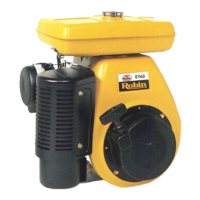8.
ROBIN
SOLID
STATE IGNITION ENGINE (OPTION)
8-1 FEATURES
The
S.S.I.
system is free
of
the weak points of the conventional point type ignition system, that is, ignition failure due to a
dirty or burnt contact point, oxidation during long storage,and mechanical wear,and
featuresmaintenance-free
performance,
proper sparking, and freedom from the
ill
effects of water,
oil
dust, and moisture.
8-2
BASIC CIRCUIT
and
OPERATING THEORY
of
S.S.
I.
SYSTEM
1)
As the flywheel and magneto rotate, a voltage is in-
duced
in
the exciter coil, and flows through the pri-
mary wire to the transistor base.
A
2)
At the same time, the transistor is energized to form a
circuit between the exciter coil and the transistor.
B
3)
At the ignition time, electric power flows from the
pulser coil to the
SCR
gate to energize the
SCR.
C
Thus the current flowing to the transistor is cut off,
and the exciter current suddenly rushes to the prima-
ry side of the ignition coil.
D
Thus, a high voltage is
generated
on
the secondary side
of
the ignition coil to
produce a spark in the spark plug.
E
8-3 CHECKING IGNITION UNIT
with
TESTER
The ignition unit can be checked with an ordinary circuit
tester.
Checkit as shown in the table at right, and if the test results
are
as
specified, the ignition unit
is
in normal condition. If
any
of
the
test results
is
not satisfactory, replace the whole
ignition unit.
NOTE:
Use
a
circuit tester, not a megger
or
other
tester
that
requires
high
ovltage.
ON
in
the
table indicates the forward characteristic
of
the diode, and
if
the tester pointer moves to
a
certain extent,
it
is good.
OFF
in
the table indicates
ma.
IGNITION UNIT
"-1
IGNITION
COIL
L
Fig.
50
Connect
(+)
terminal
of
tester.
I
8-4
MEASURING RESISTANCES
of
EXCITER COIL
and
PULSER COIL
Exciter
Coil
A-tB A+B
Pulser Coil
STD
t
4.5R
*
20%
150W
66Q
*
20%
0.97Q
*
20%
Fig.
51
*
Values
in
the table above apply where ambient temperature is 20°C.
-
29
-

